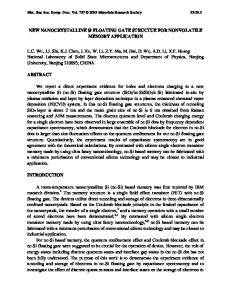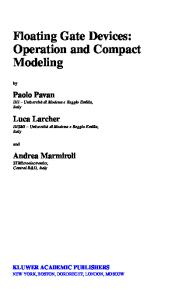Observation of Quantum Confinement Effects in Nanocrystalline Silicon Dot Floating Gate Single Electron Memory Devices
- PDF / 171,825 Bytes
- 6 Pages / 612 x 792 pts (letter) Page_size
- 69 Downloads / 318 Views
F11.3.1
Observation of Quantum Confinement Effects in Nanocrystalline Silicon Dot Floating Gate Single Electron Memory Devices Shaoyun Huang, Souri Banerjee, and Shunri Oda Research Center for Quantum Effect Electronics, Tokyo Institute of Technology, 2-12-1 O-okayama, Meguro-Ku, Tokyo 152-8552, JAPAN ABSTRACT Electron charging and discharging processes in floating gate MOS memory based on nanocrystalline silicon (nc-Si) dots were investigated at room temperature using capacitance-voltage (C-V) and conductance-voltage (G-V) measurements. Sequential electron discharging processes from nc-Si dots manifest themselves clearly in G-V spectroscopy after charging of the dots. According to the conductance peak structure resulting from the Coulomb blockade as well as quantum confinement effects of nc-Si dots, electron-addition energy is estimated to be 50 meV. Taking the electron-charging energy between the silicon substrate and the floating dot (30 meV) into account, the quantum confinement energy is found to be comparable to the electron charging energy for an nc-Si dot of 8 nm in diameter embedded in the silicon oxide. INTRODUCTION Recently, using nc-Si dots as a floating gate, single-electron-memory (SEM) devices attract considerable attentions, where fast write/erase speed, long retention time and superior endurance with non-destructive read are presented [1]. In the device operation, only a few electrons are transferred in the programs (write/store/erase). Moreover, to add/remove each electron into/from the nc-Si dot, one must overcome sufficient addition energy inducing to an oscillation of conductance in the transport processes of carriers [2]. For a nanometer-scale semiconductor dot, the electron’s Fermi wavelength becomes comparable to the dot size, therefore the energy-level separation also becomes comparable to the electron charging energy or the thermal kinetic energy even at room temperature [3]. Instead of classical Coulomb-blockade theory, in which the energy-level separation was not taken into account, a theory that includes the effects of the discreteness of the energy spectrum was developed for semiconductor quantum dots [4]. To further understand such a multi-electron system, the electronic properties of nc-Si dot including Coulomb charging and quantum confinement effects should be identified, which are indispensable for coming SEM device applications. A presence of charges inside a nanocrystal may manifest itself in capacitance-voltage (C-V) characteristics by a shift in the threshold voltage and results in a conductance oscillation in conductance-voltage (G-V) characteristics [5]. In this letter, we present the evidence for electrons releasing from nc-Si dots and the estimation of electron quantum confinement energy. The charging and discharging processes, associated with electron energy levels of nc-Si dot, are also discussed. EXPERIMENTAL DETAILS The proposed sample is a memory device with a SiO2/nc-Si dots/SiO2 structure on a silicon
F11.3.2
Gate Electrode Upper Oxide 46 nm
Upper oxide
tupper:
Data Loading...






